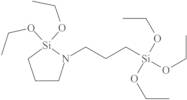
(1-(3-TRIETHOXYSILYL)PROPYL)-2,2-DIETHOXY-1-AZA-2-SILACYCLOPENTANE, tech
CAS: 1184179-50-7
Ref. 3H-SIT8187.2
| 25g | To inquire |
Product Information
1-(3-triethoxysilyl)propyl-2,2-diethoxy-1-aza-2-silayclopentane
Used for metal oxide films and microparticle surface modificationAdvanced silane in Sivate A610 Activated silane blendDipodal analog: SIB1824.5
Cross-Linking Cyclic Azasilane
Cyclic azasilanes react rapidly, less than one minute, with any and all surface hydroxyl groups is therefore of unique interest for surface modification. Volatile cyclic azasilanes afford high functional density monolayers on inorganic surfaces such as nanoparticles and other nanofeatured substrates without a hydrolysis step or the formation of byproducts. They exploit the Si-N and Si-O bond energy differences affording a thermodynamically favorable ring-opening reaction with surface hydroxyls at ambient temperature.
Amine Functional Silane Coupling Agent
Silane coupling agents have the ability to form a durable bond between organic and inorganic materials to generate desired heterogeneous environments or to incorporate the bulk properties of different phases into a uniform composite structure. The general formula has two classes of functionality. The hydrolyzable group forms stable condensation products with siliceous surfaces and other oxides such as those of aluminum, zirconium, tin, titanium, and nickel. The organofunctional group alters the wetting or adhesion characteristics of the substrate, utilizes the substrate to catalyze chemical transformations at the heterogeneous interface, orders the interfacial region, or modifies its partition characteristics, and significantly effects the covalent bond between organic and inorganic materials.
Dipodal Silane
Dipodal silanes are a series of adhesion promoters that have intrinsic hydrolytic stabilities up to ~10,000 times greater than conventional silanes and are used in applications such as plastic optics, multilayer printed circuit boards and as adhesive primers for ferrous and nonferrous metals. They have the ability to form up to six bonds to a substrate compared to conventional silanes with the ability to form only three bonds to a substrate. Many conventional coupling agents are frequently used in combination with 10-40% of a non-functional dipodal silane, where the conventional coupling agent provides the appropriate functionality for the application, and the non-functional dipodal silane provides increased durability. Also known as bis-silanes additives enhance hydrolytic stability, which impacts on increased product shelf life, ensures better substrate bonding and also leads to improved mechanical properties in coatings as well as composite applications.
Chemical properties
Technical inquiry about: 3H-SIT8187.2 (1-(3-TRIETHOXYSILYL)PROPYL)-2,2-DIETHOXY-1-AZA-2-SILACYCLOPENTANE, tech
If you want to request a quotation or place an order, please instead add the desired products to your cart and then request a quotation or order from the cart. It is faster, cheaper, and you will be able to benefit from the available discounts and other advantages.





